Srinagar Tourism
Srinagar is the capital of the northernmost Indian state of Jammu and Kashmir. It is situated in Kashmir Valley and lies on the banks of the Jhelum River, a tributary of the Indus. While not the largest, it is one of the biggest cities in India without a Hindu majority. The city is famous for its lakes and houseboats. It is also known for traditional Kashmiri handicrafts and dry fruits. It is also the headquarters of Srinagar district.
Etymologically Srinagar is composed of two Sanskrit words, namely, Sri and Nagar, which means a city. Thus, the word Srinagar signifies a place of wealth and abundance. Sri is also the name of a goddess Lakshmi of Hindus. Sri is also used for, sun, hence the word could mean, city of the sun.
One theory of the origin of the name is that a Pandava King Ashoka (not to be confused with Maurya Ashoka) built the city of Srinagari (Srinagar). Another theory is that in Kashmir Mauryan Emperor Ashoka founded the original city of Srinagar, then situated on the site of the present village of Pandrathan, 3 miles to the North of the existing capital.
The city is located on both the sides of the Jhelum River, which is called Vyath in Kashmir. The river passes through the city and meanders through the valley, moving onward and deepening in the Wular Lake. The city is famous for its nine old bridges, connecting the two parts of the city.
Hokersar is a wetland situated near Srinagar—the capital of Indian Kashmir. Thousands of migratory birds come to Hokersar from Siberia and other regions in the winter season. Migratory birds from Siberia and Central Asia use wetlands in Kashmir as their transitory camps between September and October and again around spring. These wetlands play a vital role in sustaining a large population of wintering, staging and breeding birds.
Hokersar is 14 kilometres (8.7 mi) north of Srinagar, and is a world class wetland spread over 13.75 square kilometres (5.31 sq mi) including lake and marshy area. It is the most accessible and well-known of Kashmir's wetlands which include Hygam and hygam is the best place of situation, Shalibug and Mirgund. A record number of migratory birds have visited Hokersar in recent years. An estimated quarter of a million birds have already been spotted at Hokersar in the current season.
Birds found in Hokersar—Migratory ducks and geese which include Brahminy Duck, Tufted Duck, Gadwall, Garganey, Greylag Goose, Mallard, Common Merganser, Northern Pintail, Common Pochard, Ferruginous Pochard, Red-Crested Pochard, Ruddy Shelduck, Northern Shoveler, Common Teal, and Eurasian Wigeon.
How to Reach Srinagar
By Road: Srinagar is well connected by road network with Jammu, Kargil and other neighbouring areas.
Some important distaces from Srinagar:
Srinagar to Chnadigarh: 630 km
Srinagar to Jammu: 290 km
Srinagar to Delhi: 876 km
Srinagar to Leh: 434 km
Srinagar to Pahalgam: 96 km
By Rail: The nearest railway station to Srinagar is Jammu, which is at a distance of 290 km. Jammu is well connected by rail with major cities of India.
By Air: Srinagar airport is is 14 km from the city.
Best Time to Visit Srinagar
April to October is the best season to visit Srinagar.
Srinagar Weather
Map of Srinagar
Places to Visit in Srinagar
Dal Lake
Dal Lake is a lake in Srinagar, the summer capital of the northernmost Indian state of Jammu and Kashmir. The urban lake, which is the second largest in the state, is integral to tourism and recreation in Kashmir and is nicknamed the "Jewel in the crown of Kashmir" or "Srinagar's Jewel". The lake is also an important source for commercial operations in fishing and water plant harvesting.
The shore line of the lake, about 15.5 kilometres (9.6 mi), is encompassed by a boulevard lined with Mughal era gardens, parks, houseboats and hotels. Scenic views of the lake can be witnessed from the shore line Mughal gardens, such as Shalimar Bagh and Nishat Bagh built during the reign of Mughal Emperor Jahangir) and from houseboats cruising along the lake in the colourful shikaras. During the winter season, the temperature sometimes reaches -11 °C (12 °F), freezing the lake.
The lake covers an area of 18 square kilometres (6.9 sq mi) and is part of a natural wetland which covers 21.1 square kilometres (8.1 sq mi), including its floating gardens. The floating gardens, known as "Rad" in Kashmiri, blossom with lotus flowers during July and August. The wetland is divided by causeways into four basins; Gagribal, Lokut Dal, Bod Dal and Nagin (although Nagin is also considered as an independent lake). Lokut-dal and Bod-dal each have an island in the centre, known as Rup Lank (or Char Chinari) and Sona Lank respectively.
At present, the Dal Lake and its Mughal gardens, Shalimar Bagh and the Nishat Bagh on its periphery are undergoing intensive restoration measures to fully address the serious eutrophication problems experienced by the lake. Massive investments of around US $275 million (Rs 1100 crores) is being made by the Government of India to restore the lake to its original splendour.
Wular Lake
Wular Lake is a large fresh water lake in Bandipore district in the Indian state of Jammu and Kashmir. The lake basin was formed as a result of tectonic activity and is fed by the Jhelum River. The lake's size varies from 12 to 100 square miles (30 to 260 square kilometers), depending on the season.
Island of Char Chinar
A famous landmark in Srinagar is an island on Dal Lake where four Chinar (Platanus orientalis) trees stand, named "Char Chinar". Char in Hindi and Urdu means four.
Nagin Lake
Nagin Lake, though sometimes referred to as a separate lake, is actually part of Dal Lake, being linked through a causeway which permits only bikers and walkers to enter the lake precincts. The caseway carries the water supply pipeline to the Srinagar city in the east. The lake is bounded by the Shankaracharya hill (Takht-e-Suleiman) on the south and Hari Parbat on the west and is located at the foot of the Zabarwan hills. Willow and poplar trees flank the edges of the lake.
Chashme Shahi
Chashme Shahi, meaning "Royal Spring", is a fresh water spring and garden known for its medicinal properties. Its source located above the Nehru Memorial Park. It is the smallest of all the Mughal gardens in Srinagar, measuring 108 metres (354 ft) x 38 metres (125 ft) and it has three terraces, an aqueduct, waterfalls and fountains. Ali Mardan Khan built the garden in 1632, and is built in a such a way that the spring water is the source of fountains. From the fountains, water flows along the floor of the pavilion and cascades to a lower terrace over a drop of 5 metres (16 ft) along a polished black stone chute. A small shrine, known as the Chasma Sahibi, is located in the vicinity of the gardens and has a fresh water spring.
Shankaracharya Temple
The sacred Shankaracharya temple, also known as Jyeshteswara, occupies the top of the hills (about 1,000 feet (300 m) above the surrounding Takht-I-Sulaiman plains in the south-east of Srinagar. The site, initially named Gopadri, dates back to 250 BC as a Buddhist monument, probably built by Emperor Ashoka's son Jhaloka. In the 7th century it was replaced by the present temple by King Lalitaditya. The philosopher Shankaracharya is documented as having stayed at this place when he visited Kashmir ten centuries ago to revive Sanatana Dharma.
Built on a high octagonal plinth (20 feet (6.1 m) high) on solid rock and approached by a flight of steps with side walls that once bore inscriptions, the main surviving shrine consists of square building with a circular cell. It overlooks the Srinagar valley and can be approached by car. A modern ceiling covers the inner sanctum and a Persian inscription traces its origin to the reign of Emperor Shah Jahan. There is also a Shiva Linga coiled by a serpent, located in a basin inside the sanctum. The original ceiling was dome-shaped and the current brick roof is said to be about a century old.
Hari Parbat
Hari Parbat, also known as the Mughal fort, is a hill fort on Sharika hill that provides panoramic views of the Srinagar city and the Dal Lake. It was first established by Mughal Emperor Akbar in 1590. However, he only erected the outer wall of the fort and his plans to build a new capital called Naga Nagor within it did not materialise. The fort in its current state was built much later in 1808 under the reign of Shuja Shah Durrani. Within the fort's precincts are temples, Muslim shrines, and a sikh Gurudwara. The hill is the subject of many legends in Hindu mythology, and was said to have once been a large sea, inhabited by a demon known as Jalobhava and that the hill grew from a pebble.
Hazratbal Shrine
The Hazratbal Shrine, also named Hazratbal, Assar-e-Sharief, Madinat-us-Sani, or simply Dargah Sharif, is a Muslim shrine situated on the left bank of the Dal Lake and is considered to be Kashmir's holiest Muslim shrine. It contains a relic believed by many Kashmiri Muslims to be the Moi-e-Muqqadas, a hair from the head of the Islamic Prophet Muhammad PBUH. According to legend, the relic was first brought to India by Syed Abdullah, a descendant of Muhammad PBUH who left Medina and settled in Bijapur, near Hyderabad in 1635. When Syed Abdullah died, his son, Syed Hamid, inherited the relic. Following the Mughal conquest of the region, Syed Hamid was stripped of his family estates. Finding himself unable to care for the relic, he gave it as the most precious gift to his close Mureed and a wealthy Kashmiri businessman, Khwaja Nur-ud-Din Ishbari.
Nishat Bagh
Nishat Bagh, is a Mughal garden built on the eastern side of the Dal Lake, close to the Srinagar city in the state of Jammu and Kashmir. It is the second largest Mughal garden in the Kashmir Valley. The largest in size is the Shalimar Bagh, which is also located on the bank of the Dal Lake. ‘Nishat Bagh’is a Hindustani word, which means "Garden of Joy," "Garden of Gladness" and "Garden of Delight.
Shalimar Bagh
Shalimar Bagh, is a Mughal garden linked through a channel to the northeast of Dal Lake, on its right bank located at 34.149°N 74.873°E near Srinagar city in the Jammu and Kashmir. Its other names are Shalamar Garden, Shalamar Bagh, Farah Baksh and Faiz Baksh, and the other famous shore line garden in the vicinity is Nishat Bagh. The Bagh was built by Mughal Emperor Jahangir for his wife Nur Jahan, in 1619. The Bagh is considered the high point of Mughal horticulture. It is now public park.
Jama Masjid
Jama Masjid is a mosque in Srinagar, Jammu & Kashmir, India. The Jama Masjid of Srinagar is situated at Nowhatta, in the middle of the old city. An important mosque in Srinagar, it was built by Sultan Sikandar in 1400 AD. Later, the son of Sultan Sikandar, Zain-ul-Abidin got the mosque extended. The attractions of the Jama Masjid of Srinagar, Kashmir include beautiful Indo-Saracenic architecture, a magnificent courtyard and 370 wooden pillars. Another feature of the mosque is the peace and tranquility inside it, standing out against the hustle of the old bazaars around it. Thousands of Indian Muslims assemble at the mosque every Friday to offer their prayers.
Jama Masjid of Srinagar has been subject to much destruction till date. Thrice this magnanimous mosque was ruined by fire but was restored after every disaster. The last restoration work was carried out under the reign of Maharaja Pratap Singh. Still today this mosque stands tall like the pride of Srinagar, holding within itself rich stories from the past and calling all Muslims to pray five times a day.
Kashmir Houseboat and Shikara
Houseboats and the Dal Lake are widely associated with Srinigar and are nicknamed "floating palaces", built according to British customs. The houseboats are generally made from local cedar-wood and measure 24–38 metres (79–125 ft) in length and 3–6 metres (9.8–20 ft) in width and are graded in a similar fashion to hotels according to level of comfort. Many of them have lavishly furnished rooms, with verandas and a terrace to serve as a sun-deck or to serve evening cocktails. They are mainly moored along the western periphery of the lake, close to the lakeside boulevard in the vicinity of the Dal gate and on small islands in the lake. They are anchored individually, with interconnecting bridges providing access from one boat to the other. The kitchen-boat is annexed to the main houseboat, which also serves as residence of the boatkeeper and his family.
Each houseboat has an exclusive shikara for ferrying guests to the shore. A shikara is small paddled taxi boat, often about 15 feet (4.6 m) long) and made of wood with a canopy and a spade shaped bottom. It is the cultural symbol of Kashmir and is used not only for ferrying visitors but is also used for the vending of fruits, vegetables and flowers and for the fishing and harvesting of aquatic vegetation. All gardens in the lake periphery and houseboats anchored in the lake are approachable through shikaras. The boats are often navigated by two boatmen dressed in "Phiron" (traditional dress) and carry 'Kangris' or portable heaters on the boat. A shikara can seat about six people and have heavily cushioned seats and backrests to provide comfort in Mughul style. All houseboat owners provide shikara transport to their house guests free of charge. The shikara is also used to provide for other sightseeing locations in the valley, notably a cruise along the Jhelum River, offering scenic views of the Pir Panjal mountains and passing through the famous seven bridges and the backwaters enroute.
Srinagar Photos
Hotels in Srinagar
Comrade Inn
Hotel Season Palace
Hotel Dawer Heaven
Hotel Dar-Es-Salam
Swan Group of House Boat
Royal Group of Deluxe Houseboats
Welcome Hotel

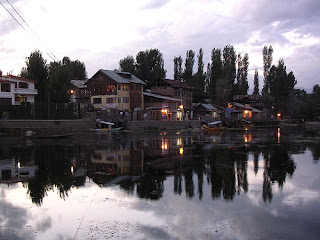
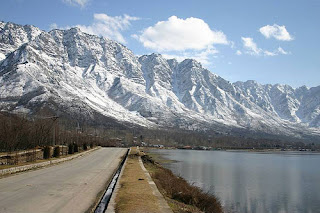







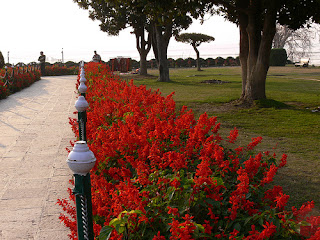





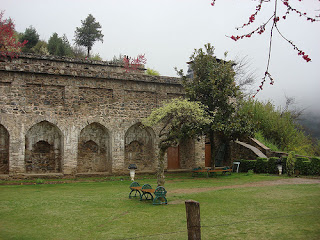
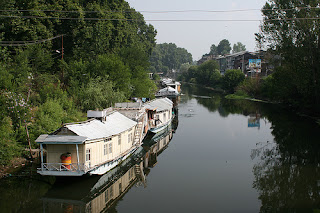



No comments:
Post a Comment